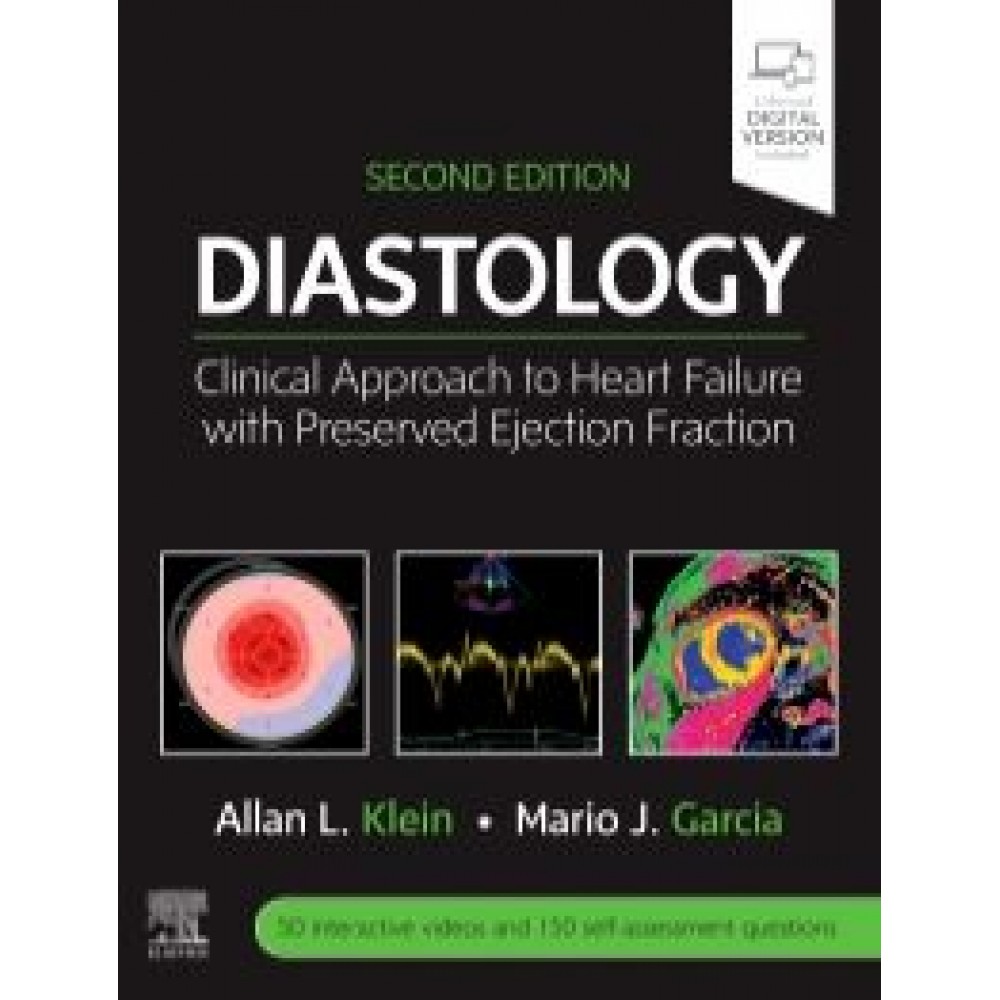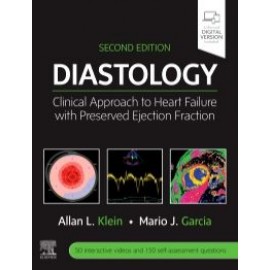Diastology, 2nd Edition
Descripcion del producto
| ISBN Number | 9780323640671 |
| Main Author | By Allan L. Klein, MD and Mario J. Garcia, MD, FACC |
| Copyright Year | 2021 |
| Edition Number | 2 |
| Format | Book |
| Trim | 276 x 216 (8 1/2 x 10 7/8) |
| Illustrations | Approx. 400 illustrations (350 in full color) |
| Imprint | Elsevier |
| Page Count | 544 |
| Publication Date | 18 Nov 2020 |
| Stock Status | IN STOCK |
Book Description
Accounting for more than 40% of all heart failure problems diastolic heart failure is a complex and often difficult diagnosis with rapidly evolving diagnostic management protocols. Diastology: Clinical Approach to Heart Failure with Preserved Ejection Fraction 2nd Edition brings you up to date and equips you to successfully diagnose and manage even the most challenging incidences of diastolic heart failure and their comorbidities. It incorporates the latest guidelines for the diagnostic evaluation of the patient with suspected or known diastolic dysfunction provides a comprehensive review of clinical conditions associated with heart failure with preserved ejection fraction and describes the complementary role of imaging modalities and novel therapeutic approaches.
Key Features
- Keeps you current with recent extensive changes in the understanding of the mechanisms of diastolic heart failure with preserved ejection fraction (HFpEF) that have resulted in dramatic changes in treatment guidelines.
- Covers the latest molecular, genetic, and cellular mechanisms behind diastolic heart failure as a basis for the latest clinical approaches, diagnosis, and treatment of common and uncommon pathological conditions such as hypertensive heart disease, cardiomyopathies, arterial and valvular diseases, pericardial diseases, congenital heart disease, diabetes mellitus, and metabolic syndrome.
- Features 50 video cases, new key summary points, new multiple-choice review questions, and six new chapters: Evaluation of Diastolic Function by Radionuclide Techniques; Diastology Stress Test; ASE/EACVI Diastolic Guidelines; Valve Disease; Perioperative Assessment of Diastolic Dysfunction; and Pulmonary Hypertension.
- Reviews new techniques and indices for assessing diastolic function, such as 3D echo, strain rate imaging, late gadolinium enhancement and T1-mapping by CMR, and novel nuclear scintigraphic methods ? as well as the traditional indices of LV filling, LA function, and tissue Doppler indices.
- Covers emerging topics such as the role of neurohormones, global and regional systolic function of the left ventricle, chronotopic incompetence and pacing, aging, perioperative assessment, and more.
- Presents information in a quick-retrieval format, covering Epidemiology, Pathophysiology, Diagnostic Evaluation, Differential Diagnosis, Treatment, and Future Directions.
- Helps you learn efficiently and prepare for specialty board examination with key summaries and multiple-choice questions and answers for each chapter.
- Enhanced eBook version included with purchase. Your enhanced eBook allows you to access all of the text, figures, and references from the book on a variety of devices.
Author Information
Book Contents
Part I: Basic Determinants of Diastolic Function
- Molecular, Gene, and Cellular Mechanis
- Pathophysiology of Heart Failure With a Preserved Ejection Fraction: Measurements and Mechanisms Causing Abnormal Diastolic Function
- Role of the Pericardium in Diastolic Dysfunction
- Left Atrial Function: Basic Physiology
- Physical Determinants of Diastolic Flow
- Ventricular?Arterial Interaction in Patients With Heart Failure and a Preserved Ejection Fraction
- General Principles, Clinical Definition, Epidemiology, and Pathophysiology
- Invasive Hemodynamic Assessment in Heart Failure With Preserved Ejection Fraction
- Two-Dimensional and Doppler Evaluation of Left Ventricular Filling, Including Pulmonary Venous Flow Velocity
- Evaluation of Diastolic Function by Tissue Doppler, Strain, and Torsion Analysis
- Color M-mode Doppler
- Assessment of Left Atrial Size and Function
- Evaluation of Intracardiac Filling Pressures
- Evaluation of Right Ventricular Diastolic Function
- Evaluation of Diastolic Function by Cardiac Magnetic Resonance Imaging
- Evaluation of Diastolic Function by Radionuclide Techniques
- Diastolic Echocardiographic Examination
- Diastology Stress Test
- ASE/EACVI Diastolic Guidelines: Strength and Limitations
- Hypertension and Its Relation to Heart Failure With a Preserved Ejection Fraction
- Valve Disease
- Stage D Heart Failure With Preserved Ejection Fraction, Heart Transplantation, and Mechanical Circulatory Support
- Primary Restrictive, Infiltrative, and Storage Cardiomyopathies
- Coronary Artery Disease
- Hypertrophic Cardiomyopathy
- Pericardial Diseases: Constrictive Pericarditis and Pericardial Effusion
- Diastolic Function in Children and in Children With Congenital Heart Disease
- Diabetes Mellitus
- Global and Regional Systolic Function of the Left Ventricle
- Chronotropic Incompetence and Pacing in HPEF Heart Failure with Preserved Ejection Fraction
- Aging and Heart Failure With Preserved Ejection Fraction
- Perioperative Assessment of Diastolic Function
- Pulmonary Hypertension in Heart Failure With Preserved Ejection Fraction
- General Treatment of Heart Failure With Preserved Ejection Fraction and Randomized Trials
- Echo-Based Approach to the Management of Heart Failure With Preserved Ejection Fraction
- Future Therapies in HFpEF
- Cases of Diastolic Heart Failure
Part II: Diagnosis of Heart Failure With Preserved Ejection Fraction
Part III: Cardiac Diseases With HFpEF
Part IV: Emerging Topics in HFpEF
Part V: Treatment of HFpEF
Part VI: Cases of Diastolic Heart Failure



